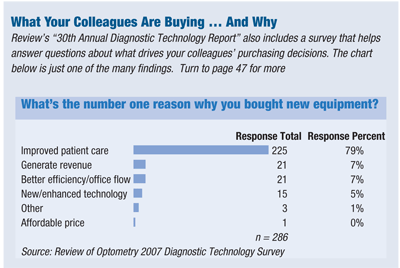 This year marks Reviews 30th consecutive year running its popular Diagnostic Technology Report. Typically, this report provides a serious, sometimes over-our-heads look at high-brow, high-priced techno gizmos in the pipeline. This years report is no less whimsical.
This year marks Reviews 30th consecutive year running its popular Diagnostic Technology Report. Typically, this report provides a serious, sometimes over-our-heads look at high-brow, high-priced techno gizmos in the pipeline. This years report is no less whimsical.
However, it is a complete 180 compared to previous years. Rather than look ahead, we look back at the technology of yesteryearor lack thereof. (However, we promise to also fill you in on many of the greatest gadgets you can get here and now.)
This months cover story, Remember When: The Evolution of Diagnostic Technology, is a collection of short essays intended to be a fun look back at how optometric practice used to be and how technology has improved your lives and those of your patients.
Robert M. Cole III, O.D., Reviews chief clinical editor, kicks things off by reminiscing about doing visual field examinations in a dark room. There, he placed little white pins into a felt wall to determine isopters of vision.
Another contributor, Pamela J. Miller, O.D., J.D., presents a bittersweet look at how the profession has evolved in the face of enormous technological advances, changing demographics and expanded scope of optometric practice. The push is to do more and do it quicker, more efficiently and more effectively, she says.
New technology, however remarkable, is a sign of change. And, making changes often means making sacrifices. For example, you may need to shorten the time you spend on each exam so you can see more patients. Likewise, you might need to sacrifice revenue to buy new instruments that will allow you to see more patients.
Whatever the case may be, many of your colleagues look back at optometry of years gone by and miss some of the elements of its more singular focus. For example, our revered contributor, Irving Bennett, O.D., says he bemoans the loss of some of the older tests and techniques, such as the use of prolonged ocular occlusion, a technique that most of our readers may never have heard of before.
Nonetheless, diagnostic technology has had a far-reaching and substantive impact on optometric practice in recent decades, says Linda Casser, O.D. In her essay, Dr. Casser points out that optometrists played a central role in developing technology and improving the standard of care by integrating new instruments into their practices and contributing to the literature describing an instruments uses, outcomes and efficacy.
Clearly, optometry and technology have a mutually beneficial relationshipone that will continue to develop exponentially with each passing year.

